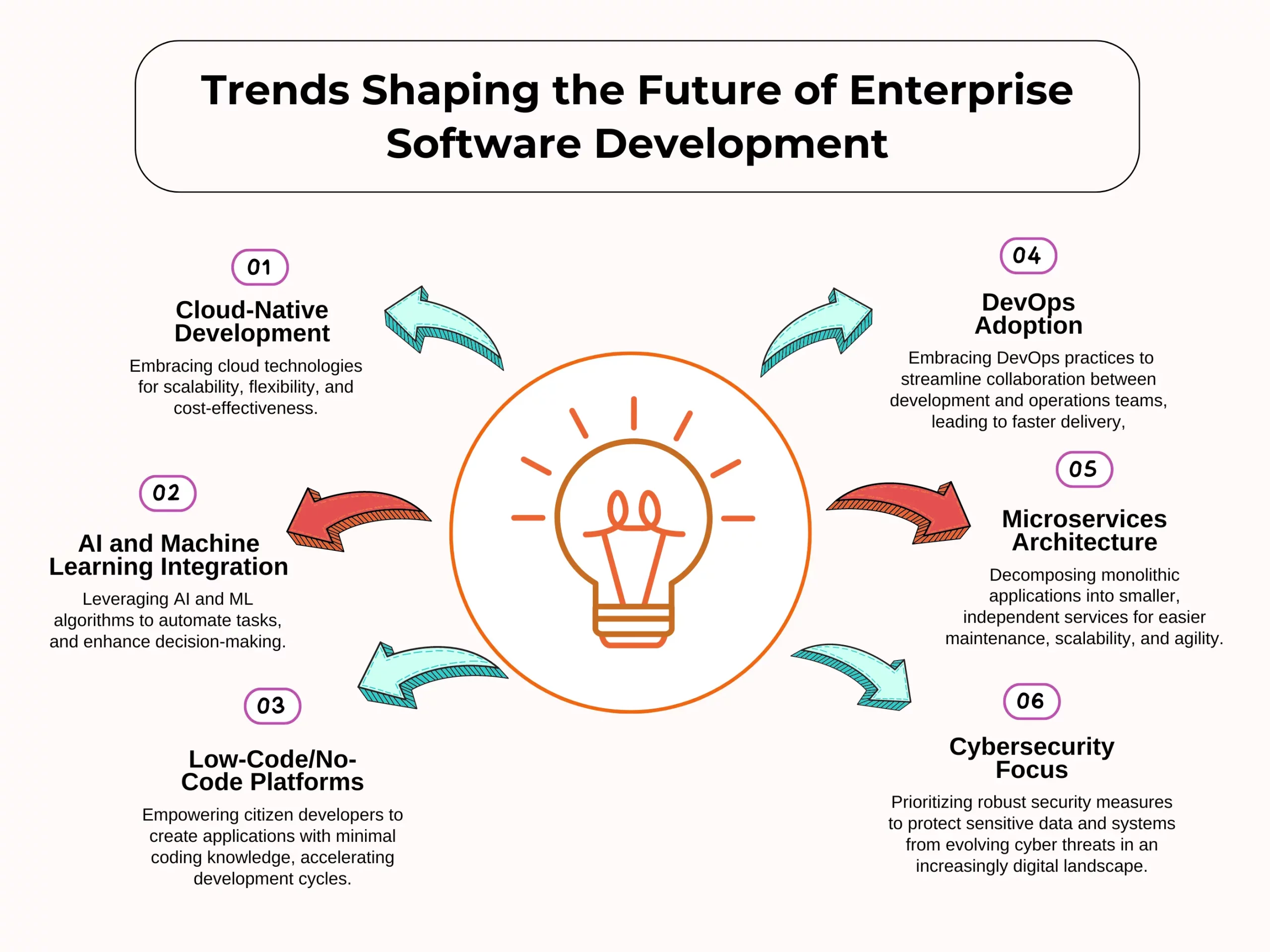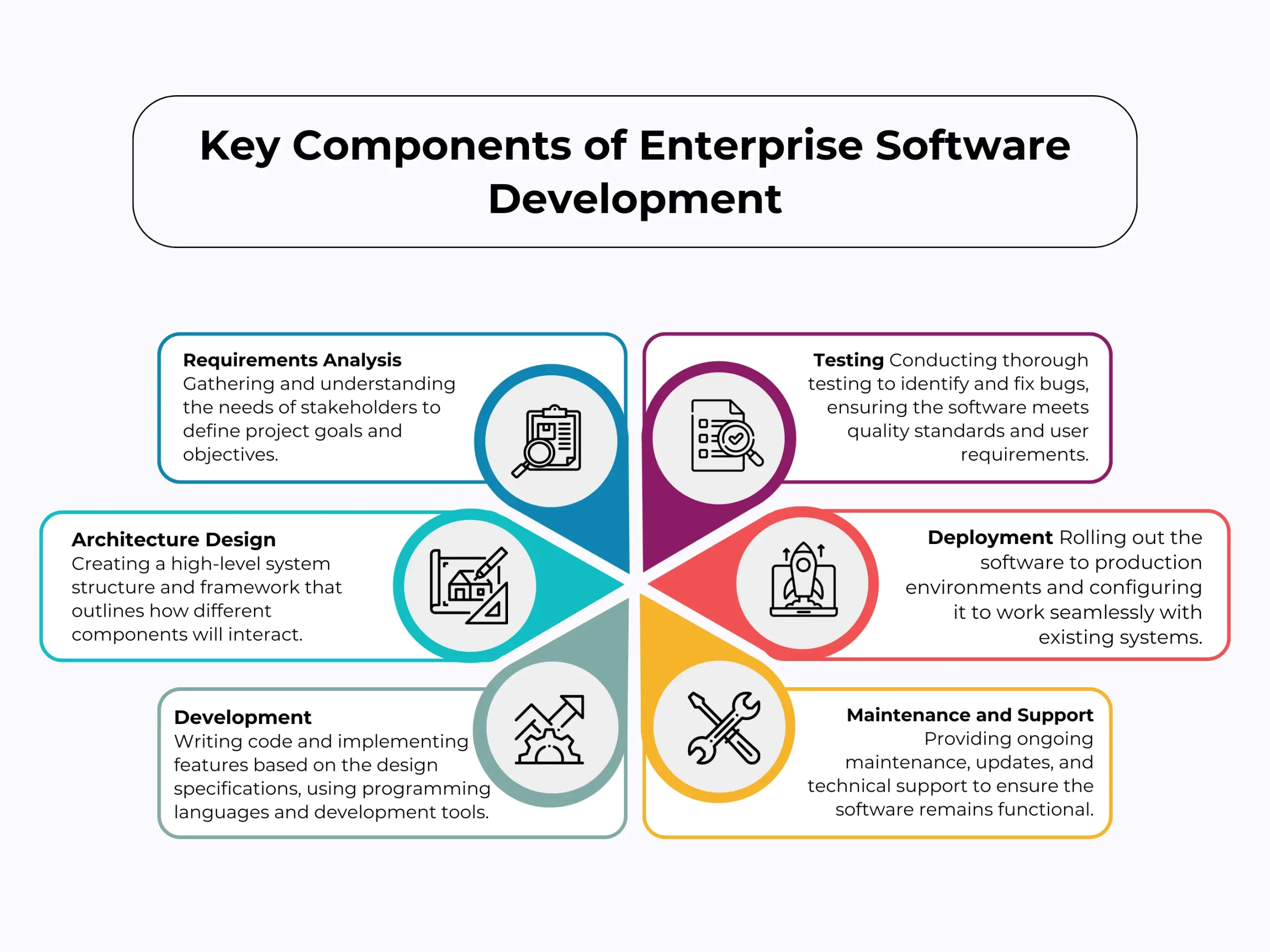The role of enterprise software development solutions has become increasingly crucial for organizations seeking to unlock their full potential and stay ahead of the competition. With the digital transformation of industries across the globe, businesses are turning to advanced software solutions to streamline processes, drive innovation, and achieve sustainable growth.
According to recent research by Market Research Future, the global enterprise software market is projected to reach a value of over $600 billion by 2026, reflecting the growing demand for sophisticated software solutions across industries. This significant market growth is driven by factors such as the increasing adoption of cloud-based technologies, the rise of mobile computing, and the need for best custom software development companies to optimize operations and enhance productivity.
Enterprise software development solutions encompass a wide range of applications and technologies designed to address modern businesses’ unique needs and challenges. From custom software development to enterprise resource planning (ERP) systems, customer relationship management (CRM) platforms, and industry-specific solutions, these software offerings empower organizations to streamline workflows, improve collaboration, and make data-driven decisions.
We will explore the key features, benefits, and considerations of enterprise software development solutions. From understanding the role of enterprise software in business growth to evaluating ROI and measuring success, we will provide valuable insights and practical advice to help custom enterprise software development companies navigate the complex landscape of enterprise software and make informed decisions.
Whether you’re a startup looking to scale your operations or an established enterprise aiming to stay ahead of the curve, this guide will serve as your roadmap to unlocking the full potential of your business through enterprise software development solutions. Join us on this journey as we explore the transformative power of software in driving business success in the digital age.
Ready to Build? Let’s Create Your Enterprise Software Solution Today!
What Do You Mean By Enterprise Software Development Solutions?
Enterprise software development solutions encompass a broad spectrum of technologies, tools, and methodologies designed to address the specific needs and challenges of businesses operating in diverse industries. These solutions are tailored to facilitate the digital transformation of organizations, streamline operations, and drive innovation in today’s competitive marketplace.
1. Comprehensive Software Offerings
Firstly, Enterprise software development solutions encompass a wide range of applications, including custom software development, enterprise resource planning (ERP) systems, customer relationship management (CRM) platforms, and industry-specific solutions. These offerings are designed to meet the unique requirements of businesses across various sectors.
2. Tailored Solutions
Secondly, One of the key characteristics of enterprise software development solutions is their ability to be customized according to the specific needs and objectives of individual organizations. Whether it’s developing a bespoke software application or integrating existing systems, these solutions are tailored to address the challenges and opportunities faced by businesses.
3. Streamlined Operations
Thirdly, Enterprise software development solutions aim to streamline and automate business processes, improving efficiency, and reducing manual effort. By centralizing data, optimizing workflows, and enabling real-time collaboration, these solutions empower organizations to operate more effectively and achieve better results.
4. Data-Driven Decision-Making
With advanced analytics and reporting capabilities, enterprise software development solutions provide organizations with valuable insights into their operations, customers, and market trends. By leveraging data-driven decision-making, businesses can identify growth opportunities, mitigate risks, and stay ahead of the competition.
5. Scalability and Flexibility
Lastly, Enterprise software development solutions are designed to grow and evolve with businesses, providing scalability and flexibility to adapt to changing needs and requirements. Whether it’s expanding operations, entering new markets, or responding to industry trends, finally, these solutions enable organizations to remain agile and responsive in a dynamic business environment.
Understanding The Role of Enterprise Software in Business Growth
Enterprise software plays a pivotal role in driving business growth and facilitating innovation in today’s competitive landscape. From streamlining operations to enhancing customer experiences, enterprise software solutions empower custom software development companies in USA to achieve their strategic objectives and stay ahead of the curve in an ever-evolving market.
1. Streamlining Operations
Firstly, Enterprise software automates manual processes, streamlining operations and improving efficiency across various departments within an organization. By eliminating redundant tasks and optimizing workflows, businesses can allocate resources more effectively and focus on core activities.
2. Enhancing Collaboration
Secondly, Collaboration is essential for driving innovation and fostering creativity within teams. Enterprise software provides collaboration tools that enable employees to communicate seamlessly, share documents, and collaborate on projects in real-time, regardless of their location or time zone.
3. Improving Decision-Making
Thirdly, Data-driven decision-making is critical for business success in today’s data-driven economy. Enterprise software solutions collect, analyze, and visualize data from various sources, providing valuable insights that empower executives and managers to make informed decisions and drive strategic initiatives.
4. Enhancing Customer Experiences
Customer satisfaction is paramount for business growth and brand loyalty. Enterprise software solutions, such as customer relationship management (CRM) systems, enable businesses to manage customer interactions, track sales opportunities, and personalize marketing efforts, ultimately enhancing the overall customer experience.
5. Supporting Scalability
As businesses grow and expand, they require scalable solutions that can accommodate increased demand and complexity. Enterprise software solutions are designed to scale alongside businesses, providing the flexibility and agility needed to adapt to changing market conditions and accommodate future growth.
6. Ensuring Regulatory Compliance
Compliance with industry regulations and standards is essential for mitigating risks and maintaining stakeholder trust. Enterprise software solutions incorporate compliance features and functionalities that help businesses adhere to regulatory requirements and avoid costly penalties.
7. Facilitating Innovation
Lastly, Innovation is the driving force behind business growth and competitiveness. Enterprise software solutions provide the technological infrastructure and tools needed to experiment with new ideas, develop innovative products and services, and stay ahead of market trends.
Enterprise software plays a multifaceted role in driving business growth by streamlining operations, enhancing collaboration, improving decision-making, enhancing customer experiences, supporting scalability, ensuring regulatory compliance, and facilitating innovation. Finally, by leveraging the capabilities of enterprise software solutions, organizations can achieve their strategic objectives and thrive in today’s dynamic business environment.
Exploring Key Features and Capabilities of Enterprise Software Development Solutions
Enterprise software development companies encompass a wide range of features and capabilities designed to address modern businesses’ unique needs and challenges. From custom software development to industry-specific applications, these solutions empower organizations to optimize operations, enhance collaboration, and drive innovation. In this section, we will explore the key features and capabilities of enterprise software development solutions and their significance in driving business success.
1. Customization and Flexibility
Firstly, Enterprise software development solutions offer high customization and flexibility, allowing businesses to tailor the software to their specific workflows, processes, and objectives. Custom-built applications ensure that businesses can meet their unique requirements and adapt to changing market conditions with ease.
2. Scalability and Performance
Secondly, Scalability is crucial for businesses experiencing growth or fluctuations in demand. Enterprise software solutions are designed to scale seamlessly, accommodating increased users, data, and transaction volumes without sacrificing performance. This scalability ensures that businesses can continue to operate efficiently as they expand.
3. Integration Capabilities
Thirdly, Integration with existing systems and applications is essential for seamless data flow and process automation. Enterprise software development solutions offer robust integration capabilities, enabling businesses to connect disparate systems, streamline workflows, and eliminate data silos. Integrated software ecosystems facilitate collaboration and data-driven decision-making across the software re engineering services.
4. Security and Compliance
Security is a top priority for businesses handling sensitive data and confidential information. Enterprise software solutions incorporate robust security features and compliance measures to protect against cyber threats and ensure regulatory compliance. Advanced encryption, access controls, and audit trails safeguard data integrity and maintain stakeholder trust.
5. Advanced Analytics and Reporting
Data-driven insights are invaluable for informed decision-making and strategic planning. Enterprise software solutions include advanced analytics and reporting capabilities, allowing businesses to analyze data from multiple sources, uncover trends and patterns, and derive actionable insights. Interactive dashboards, predictive analytics, and ad-hoc reporting empower users to make data-driven decisions quickly and efficiently.
6. Mobile Accessibility
In today’s mobile-driven world, remote access to enterprise software is essential for workforce productivity and flexibility. Enterprise software solutions offer mobile accessibility, enabling users to access critical business applications and data from anywhere, anytime, using any device. Mobile apps and responsive web interfaces ensure that employees can stay connected and productive on the go.
7. Collaboration Tools
Collaboration is key to driving innovation and achieving business goals. Enterprise software solutions include collaboration tools such as document sharing, task management, and real-time messaging, facilitating seamless communication and collaboration among team members. Integrated collaboration features enhance productivity and foster teamwork across departments and locations.
8. Continuous Support and Updates
Lastly, Enterprise software development solutions require ongoing maintenance, support, and updates to ensure optimal performance and reliability. Trusted software vendors provide continuous support services, including troubleshooting, bug fixes, and software updates, to address issues and enhance functionality over time. Finally, regular updates and patches ensure that businesses can leverage the latest features and security enhancements to stay competitive in the market.
Unlock Your Business Potential with Custom Enterprise Software Solutions. Contact us Today!
Addressing Concerns and Misconceptions About Enterprise Software Development
Enterprise software development plays a pivotal role in driving business growth and innovation. However, there are often concerns and misconceptions surrounding the adoption of enterprise software solutions. In this section, we will address some common concerns and misconceptions about enterprise software development and provide clarity on their significance and benefits.
1. Cost-Prohibitive
Misconception:
Enterprise software development is perceived as expensive and out of reach for small and medium-sized businesses (SMBs).
Reality:
While enterprise software development may require an upfront investment, the long-term benefits outweigh the initial costs. However, customized solutions can be tailored to fit the budget and specific needs of SMBs, offering scalability and flexibility for future growth.
2. Complexity and Implementation Challenges
Misconception:
Enterprise software solutions are complex to implement and require extensive training for employees.
Reality:
While enterprise software development projects may involve complexity, reputable software vendors provide comprehensive implementation support and training services. Importantly, User-friendly interfaces and intuitive design elements minimize the learning curve for employees, ensuring smooth adoption and utilization.
3. Lack of Customization and Flexibility
Misconception:
Off-the-shelf software solutions lack customization options and cannot adapt to evolving business needs.
Reality:
Enterprise software development solutions offer high customization and flexibility, allowing businesses to tailor the software to their specific requirements. However, custom-built applications can address unique workflows, processes, and objectives, ensuring alignment with business goals.
4. Security Risks
Misconception:
Enterprise software solutions pose security risks and vulnerabilities, putting sensitive data at risk of breaches.
Reality:
Security is a top priority for enterprise software vendors, who implement robust security measures and compliance standards to protect against cyber threats. Encryption, access controls, and regular security updates mitigate risks and ensure data integrity and confidentiality.
5. Return on Investment (ROI) Concerns
Misconception:
It isn’t easy to quantify the ROI of enterprise software development, making it challenging to justify the investment.
Reality:
Enterprise software solutions offer tangible benefits such as increased efficiency, productivity, and competitive advantage. However, by streamlining operations, improving collaboration, and driving innovation, the enterprise software development company delivers measurable ROI over time.
6. Maintenance and Support Challenges
Misconception:
Enterprise software solutions require extensive maintenance and support, leading to ongoing costs and resource constraints.
Reality:
Reputable software vendors provide comprehensive maintenance and support services, including regular updates, bug fixes, and troubleshooting assistance. Service level agreements (SLAs) ensure timely resolution of issues and minimize downtime, maximizing the value of enterprise software investments.
Steps for Successful Implementation of Enterprise Software Solutions
Successful implementation of enterprise software solutions is crucial for maximizing the benefits and achieving business objectives. From planning and preparation to deployment and adoption, a structured approach is essential to ensure a smooth and effective implementation process. In this section, we will outline the key steps for the successful implementation of enterprise software solutions.
1. Needs Assessment and Planning
Firstly, Conduct a comprehensive needs assessment to identify business requirements, objectives, and challenges. Define clear goals and objectives for the software implementation project. Software development outsourcing services should develop a detailed implementation plan outlining timelines, resources, and milestones.
2. Vendor Selection and Collaboration
Secondly, Research and evaluate potential software vendors based on their expertise, track record, and compatibility with your business needs. Engage in collaborative discussions with selected vendors to align expectations, clarify requirements, and establish a partnership for successful implementation.
3. Customization and Configuration
Thirdly, Work closely with the chosen vendor to customize and configure the software to meet your specific needs. Define user roles, permissions, and workflows to ensure optimal functionality and usability. Conduct thorough testing to identify and address any customization issues or discrepancies.
4. Training and Education
Provide comprehensive training and education programs for employees to ensure they are proficient in using the new software. Offer hands-on training sessions, workshops, and online resources to familiarize users with the features, functionalities, and best practices of the software by a custom enterprise software development company.
5. Pilot Testing and Feedback
Conduct pilot testing of the software with a select group of users to gather feedback and identify areas for improvement. Encourage users to provide constructive feedback on usability, performance, and functionality. Use this feedback to refine and enhance the software before full deployment.
6. Deployment and Rollout
Deploy the software in a phased approach, starting with a small-scale rollout before gradually expanding to larger user groups or departments. Ensure seamless integration with existing systems and applications to minimize disruption and downtime during the rollout process.
7. Monitoring and Optimization
Monitor the performance and usage of the software post-deployment to identify any issues or areas for optimization. Track key performance indicators (KPIs) such as user adoption rates, system uptime, and productivity metrics. Continuously optimize the software based on user feedback and evolving business needs.
8. Continuous Support and Maintenance
Lastly, Provide ongoing support and maintenance for the software to address any issues, bugs, or technical challenges that may arise. However, offer timely software updates, patches, and enhancements to ensure the software remains up-to-date and aligned with changing business requirements.
Don’t Miss Out on Maximizing Your Business Growth. Request a Free Consultation Today!
Evaluating ROI and Measuring Success of Enterprise Software Development Solutions
Evaluating the return on investment (ROI) and measuring the success of enterprise software development solutions is essential for organizations to assess the effectiveness and impact of their technology investments. By analyzing key metrics and performance indicators, businesses can determine the tangible benefits and value generated by implementing enterprise software solutions. In this section, we will explore the process of evaluating ROI and measuring success, highlighting key considerations and best practices.
1. Define Clear Objectives and Success Criteria
Firstly, Begin by defining clear objectives and success criteria for the enterprise software implementation. These objectives should align with the organization’s overall strategic goals and include measurable outcomes such as increased efficiency, cost savings, revenue growth, or improved customer satisfaction.
2. Establish Key Performance Indicators (KPIs)
Secondly, Identify and establish key performance indicators (KPIs) that will be used to measure the success and impact of the enterprise software solution. These KPIs should be relevant to the defined objectives and may include metrics such as ROI, productivity gains, process efficiency, user adoption rates, and customer satisfaction scores.
3. Track Quantifiable Metrics
Thirdly, Implement systems and processes to track quantifiable metrics related to the performance and utilization of the enterprise software solution. This may involve collecting data on factors such as time savings, cost reductions, error rates, system downtime, and revenue generated directly or indirectly through the software.
4. Conduct Regular Performance Reviews
Schedule regular performance reviews to assess the progress and effectiveness of the enterprise software solution. Analyze the collected data and compare it against the established KPIs to evaluate whether the software is meeting expectations and delivering the anticipated benefits.
5. Gather User Feedback and Insights
Solicit feedback from users and stakeholders who interact with the enterprise software solution regularly. Gather insights into their experiences, challenges, and suggestions for improvement. Best custom software development companies should incorporate this feedback into the evaluation process to gain a comprehensive understanding of the software’s impact.
6. Calculate Return on Investment (ROI)
Calculate the return on investment (ROI) of the enterprise software solution by comparing the tangible benefits generated against the costs incurred for implementation, maintenance, and support. Consider both the direct financial gains and the intangible benefits such as improved operational efficiency and competitive advantage.
7. Adapt and Adjust Strategies
Based on the findings from the evaluation process, adapt and adjust strategies as needed to optimize the performance and impact of the enterprise software solution. Identify areas for improvement and implement corrective actions to address any gaps or challenges.
8. Communicate Results and Celebrate Successes
Lastly, Communicate the results of the ROI evaluation and performance assessments to key stakeholders within the organization. Highlight successes and achievements resulting from the enterprise software implementation, and celebrate milestones to foster continued support and engagement.
How to Choose the Right Enterprise Software Development Partner?
Choosing the right enterprise software development partner is a critical decision that can significantly impact the success of your project and ultimately, your business. With countless options available in the market, it’s essential to carefully evaluate potential product engineering services providers to ensure they align with your goals, requirements, and values. In this guide, we’ll explore the key considerations and steps to help you choose the right enterprise software development partner.
1. Define Your Requirements and Objectives
Firstly, Start by clearly defining your project requirements, objectives, and expectations. Consider factors such as the scope of the project, desired features, timeline, budget, and any specific industry or regulatory compliance requirements.
2. Assess Technical Expertise and Experience
Secondly, Evaluate the technical expertise and experience of potential enterprise software development partners. Look for a partner with a proven track record of successfully delivering similar projects, relevant industry experience, and expertise in the technologies and platforms required for your project.
3. Review Portfolio and Case Studies
Thirdly, Review the portfolio and case studies of prospective partners to assess the quality of their work and the types of projects they have completed. Pay attention to projects that are similar in scope, complexity, and industry relevance to your own.
4. Evaluate Communication and Collaboration
Communication and collaboration are essential factors in the success of any software development project. Assess the partner’s communication channels, responsiveness, and ability to effectively collaborate with your internal team members and stakeholders.
5. Consider Cultural Fit and Values
Consider the cultural fit and values of potential enterprise software development partners. Look for a partner whose values align with your own ERP software development services culture and who demonstrates a commitment to transparency, integrity, and accountability.
6. Assess Scalability and Flexibility
Evaluate the scalability and flexibility of potential partners to ensure they can accommodate your project’s evolving needs and future growth. Consider factors such as team size, resources, and the ability to scale up or down as needed.
7. Review Client References and Testimonials
Reach out to past clients and request references or testimonials from previous projects. Ask about their experience working with the partner, the quality of their work, and the overall satisfaction with the partnership.
8. Consider Support and Maintenance
Consider the partner’s approach to support and maintenance services post-project completion. Custom software development companies in USA should ensure they offer ongoing support, maintenance, and updates to ensure the long-term success and sustainability of your software solution.
9. Evaluate Pricing and Budget Alignment
Evaluate the partner’s pricing structure and ensure it aligns with your budget and financial constraints. Request detailed pricing proposals and compare them against the value and quality of services offered.
10. Conduct a Trial or Proof of Concept
Lastly, Consider conducting a trial or proof of concept project with potential partners to assess their capabilities, work process, and compatibility with your team. Finally, this can help mitigate risks and ensure a successful partnership.
By following these steps and considerations, you can choose the right enterprise software development partner that best fits your needs, objectives, and values, setting the foundation for a successful collaboration and project outcome.

Summarizing The Benefits and Importance of Enterprise Software Development Solutions
Enterprise software development solutions play a crucial role in driving innovation, streamlining operations, and fueling business growth. From custom software applications to integrated enterprise resource planning (ERP) systems, these solutions offer a wide range of benefits and are essential for digital transformation services looking to stay competitive in today’s digital landscape. In this section, we’ll explore the various benefits and importance of enterprise software development solutions in detail.
Benefits:
1. Increased Efficiency and Productivity
Firstly, Enterprise software solutions automate repetitive tasks, streamline workflows, and eliminate manual processes, resulting in increased efficiency and productivity across the organization.
2. Enhanced Decision-Making
Secondly, With access to real-time data, analytics, and reporting capabilities, enterprise software solutions enable informed decision-making, helping organizations identify opportunities, mitigate risks, and drive strategic initiatives.
3. Improved Collaboration and Communication
Thirdly, Collaboration tools and communication platforms integrated into enterprise software solutions facilitate seamless collaboration among team members, departments, and external stakeholders, improving communication and fostering teamwork.
4. Scalability and Flexibility
Enterprise software solutions are designed to scale with the organization’s growth and adapt to changing business needs. They offer flexibility to accommodate new functionalities, users, and business processes as the custom software development services evolve.
5. Better Customer Experience
By centralizing customer data, automating processes, and providing personalized experiences, enterprise software solutions enhance the overall customer experience, leading to increased satisfaction, loyalty, and retention.
6. Regulatory Compliance
Lastly, Many enterprise software solutions include features and functionalities to ensure compliance with industry regulations and standards, reducing the risk of non-compliance penalties and legal issues.
Importance:
1. Strategic Alignment with Business Goals
Firstly, Enterprise software development solutions are aligned with the product engineering services’ strategic objectives, enabling the implementation of tailored solutions that address specific business challenges and opportunities.
2. Competitive Advantage
Secondly, Organizations that leverage enterprise software solutions gain a competitive advantage by optimizing operations, delivering innovative products and services, and responding quickly to market changes and customer demands.
3. Business Continuity and Resilience
Thirdly, Enterprise software solutions contribute to business continuity and resilience by providing robust infrastructure, data backup, disaster recovery, and security measures to protect against potential disruptions and threats.
4. Innovation and Adaptability
Enterprise software solutions foster innovation and adaptability by providing a platform for experimenting with new ideas, technologies, and business models, driving continuous improvement and growth.
5. Long-Term Sustainability
Investing in enterprise software development solutions ensures the long-term sustainability and viability of the organization by modernizing legacy systems, future-proofing infrastructure, and maintaining competitive relevance in the marketplace.
Looking for a Tech Upgrade? Let’s Build Your Next Enterprise Software Solution Together!
Conclusion
The comprehensive guide to unlocking business potential with enterprise software development solutions emphasizes the critical role of technology in driving organizational success and growth. By harnessing the power of innovative software solutions, businesses can streamline operations, enhance productivity, and gain a competitive edge in today’s dynamic market landscape. According to a report by Grand View Research, the global enterprise software market size is projected to reach $736.8 billion by 2027, exhibiting a compound annual growth rate (CAGR) of 8.2% from 2020 to 2027. A study also highlights the transformative impact of enterprise software on business operations, citing examples of custom software development outsourcing companies that have achieved significant cost savings, process efficiencies, and revenue growth through strategic software implementations.
As businesses navigate the complexities of digital transformation, selecting the right enterprise software development partner and implementing tailored solutions are critical success factors. The survey conducted by McKinsey & Company found that companies that effectively leverage digital technologies, including enterprise software, are more likely to outperform their peers in terms of revenue growth, profitability, and market valuation. By following best practices, conducting thorough evaluations, and aligning technology investments with strategic objectives, Custom Software Development Solutions USA can maximize the value of enterprise software and unlock its full business potential.
In essence, enterprise software development solutions serve as catalysts for innovation, agility, and growth, enabling businesses to adapt to changing market dynamics, drive operational excellence, and thrive in an increasingly competitive landscape. With the right strategy and partner by their side, businesses can embark on a transformative journey towards sustained success and prosperity.
FAQs About Enterprise Software Development Solutions
1. What are enterprise software development solutions?
Enterprise software development solutions encompass a range of technologies and services designed to address the unique needs of businesses, including custom software development, enterprise resource planning (ERP) systems, customer relationship management (CRM) software, and more. These solutions are tailored to streamline processes, enhance productivity, and drive innovation across software development outsourcing services.
2. How can enterprise software development solutions benefit my business?
Enterprise software development solutions offer numerous benefits, including improved operational efficiency, enhanced collaboration, better decision-making through data-driven insights, increased agility to adapt to market changes, and competitive advantage through innovation and differentiation.
3. What factors should I consider when selecting an enterprise software development partner?
When choosing an enterprise software development partner, it’s essential to evaluate their expertise, track record, industry experience, technological capabilities, scalability, security measures, communication channels, and ability to understand and address your specific business needs and challenges.
4. How long does it typically take to develop and implement enterprise software solutions?
The timeline for developing and implementing enterprise software solutions varies depending on the complexity of the project, the scope of requirements, and factors such as customization, integration with existing systems, testing, and deployment. It’s crucial to establish clear timelines and milestones in collaboration with your software development partner.
5. What ongoing support and maintenance services are provided with enterprise software solutions?
Most enterprise software development companies offer ongoing support and maintenance services to ensure the smooth operation of software solutions post-implementation. These services may include troubleshooting, bug fixes, updates, upgrades, security patches, performance optimization, and user training and support.
6. How can I measure the return on investment (ROI) of enterprise software development solutions?
Measuring the ROI of enterprise software solutions involves assessing factors such as cost savings, revenue growth, productivity gains, time savings, improved customer satisfaction, and competitive advantage. Key performance indicators (KPIs) and metrics should be established upfront to track and evaluate the impact of software investment outcomes on custom software development consulting companies.













